

Classroom Resources. Differentiation Planning. Getting To Know Students? Ask The Right Questions. Getting To Know Students Starts With Asking The Right Questions by Dawn Casey-Rowe, Teacher/Marketer/Spin Doctor Extraordinaire It’s back to school time!
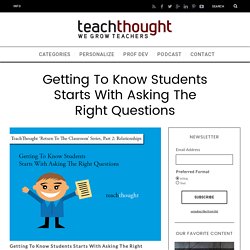
Whether you’ve been teaching for two minutes or twenty years, this is a critical time of year. You meet your students. They stare you down. When kids enter my classroom, they’re thinking, “Is this woman going to bore me to death? You wonder how you can make a fun–and meaningful–year out of… this. Should I teach problem-, project-, or inquiry-based learning? SmartBlogs. Lately, there have been a bunch of buzzwords floating around the education world that all seem to mean the same thing.
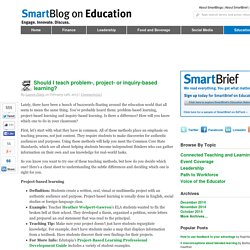
You’ve probably heard them: problem-based learning, project-based learning and inquiry-based learning. Is there a difference? How will you know which one to do in your classroom? First, let’s start with what they have in common. All of these methods place an emphasis on teaching process, not just content. Teaching Students with ADD / ADHD: Tips for Teachers to Help Students Succeed at School.
6 Tips For Creating Effective Student Groups. 6 Tips For Creating Effective Student Groups by TeachThought Staff Grouping students is easy; creating effective student groups is less so.

The following infographic from Mia MacMeekin seeks to provide some ideas to help make group work easier in your classroom. The strength of this particular graphic is in the range of the ideas. The first tip refers teachers to Vygotsky’s Zone of Proximal development, which frames student ability in terms of a range: what they can do unassisted, what they can do with the support of a More Knowledgeable Other (MKO), and what they cannot do even with support. 25 Brilliant Teacher Blogs Worth Following. There is a lot of firsthand knowledge being shared right now.

From blogging principals to teachers to education enthusiasts, there are hundreds of blogs that you should probably check out. There are some truly miraculous reasons that you should consider blogging, by the way. So, if you’re a teacher or student, perhaps you should check out some of these fabulous blogs to get a little inspiration. 3 Ways to Take Your Students Deeper With Flipped Learning. Editor's Note: This post was co-authored by Aaron Sams, Managing Director of FlippedClass.com and founding member of the Flipped Learning Network.
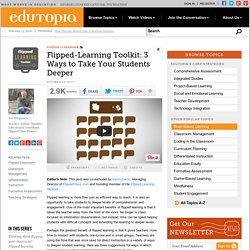
Flipped learning is more than just an efficient way to teach. It is also an opportunity to take students to deeper levels of comprehension and engagement. One of the most important benefits of flipped learning is that it takes the teacher away from the front of the room. No longer is class focused on information dissemination, but instead, time can be spent helping students with difficult concepts and extending the learning to deeper levels. Studies Confirm the Power of Visuals in eLearning. We are now in the age of visual information where visual content plays a role in every part of life. As 65 percent of the population is visual learners, images are clearly key to engaging people in eLearning courses.
Moving and still images have been included in learning materials for decades, but only now has faster broadband, cellular networks, and high-resolution screens made it possible for high-quality images to be a part of eLearning visual design. Graphic interfaces made up of photos, illustrations, charts, maps, diagrams, and videos are gradually replacing text-based courses. In this post, we will dig deep into some statistics and facts to further convince of why eLearning developers should embrace visuals when creating their courses. 1.
Both the short-term and long-term memory store information in chunks, but the former is limited. According to Dr. Furthermore, this effect increases over time. 2. According to the Visual Teaching Alliance: Image source: Uberflip Blog 4. 5. Student Engagement with Blended Learning: 9 Unique Ideas. There are many different ways to engage students, and one of those ways is through blended learning options.

By using blended learning ideas in the classroom, students often learn more easily because they are interested in the activities and the knowledge. The 40 Reflection Questions. Five Methods To Get Students Asking Essential Questions. The Question Game: A Playful Way To Teach Critical Thinking. The Question Game by Sophie Wrobel, geist.avesophos.de The Question Game: A Playful Way To Teach Critical Thinking Big idea: Teaching kids to ask smart questions on their own A four-year-old asks on average about 400 questions per day, and an adult hardly asks any.
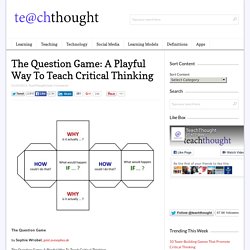
Our school system is structured around rewards for regurgitating the right answer, and not asking smart questions – in fact, it discourages asking questions. Kathy Schrock's Guide to Everything. 12 Ways To Integrate (Not Just Use) Technology In Education. There are a couple dozen ways to ‘use’ technology in education. There are also a couple dozen ways to integrate technology in education. Think those two things are the same? Think that throwing a few iPads and a few Edudemic blog posts into a classroom is the best way to launch a 1:1 initiative? In case you couldn’t guess, it’s not. Flipped classroom: Maths on Youtube.
The 33 Digital Skills Every 21st Century Teacher should Have. By EdTech Team Updated on march 2, 2015 : The original list that was created in 2011 comprised 33 skills , after reviewing it we decided to do some merging and finally ended up with the 20 skills below.
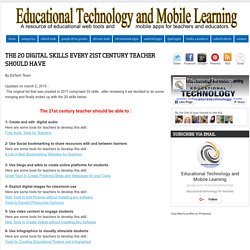
5 Tools to Help Students Learn How to Learn.